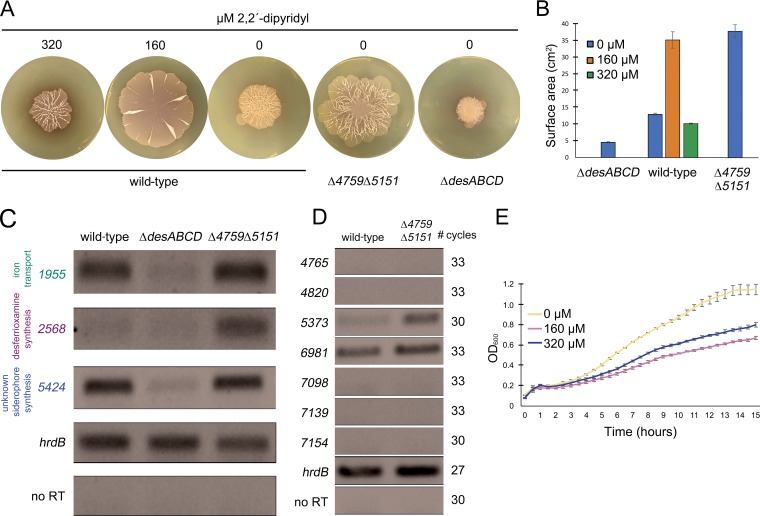FIG 5.
Iron uptake capabilities impact exploration. (A) Wild-type S. venezuelae exploring on YP media with 0, 160, or 320 µM dipyridyl, alongside the desABCD mutant and the Δsven_4759 Δsven_5151 double mutant growing on YP agar medium. Plates were incubated for 10 days. Images are representative of three replicates per strain and dipyridyl concentration (where appropriate). (B) Quantification of colony expansion by wild-type S. venezuelae, the desABCD mutant, and the Δsven_4759 Δsven_5151 double mutant on YP agar, with 0 to 320 µM dipyridyl for the wild type. Values represent means ± standard errors of results from three replicates. (C and D) Semiquantitative RT-PCR using RNA isolated from wild-type, ΔdesABCD (in panel C), and Δsven_4759 Δsven_5151 double mutant strains grown for 8 days on YP medium. Vegetative sigma factor hrdB served as a positive control for RNA loading and RNA integrity, and no-RT reactions (performed using RNA as the template with hrdB-specific primers) were included as negative controls to ensure a lack of DNA contamination of RNA samples and all PCR reagents. The number of PCR amplification cycles was optimized to ensure that the products were in the linear amplification range and that no products were observed in the negative control for each reaction. For panel C, where the expression of other siderophore-associated/iron transport genes were assessed, 30 cycles were conducted for all reactions, apart from hrdB, where 27 cycles were used. In panel D, where expression of bldK-like clusters were assessed, cycle numbers for each gene are shown to the left. For both C and D, representative results are shown for experiments conducted in biological duplicate and technical triplicate. (E) Growth curves of wild-type S. venezuelae grown in liquid YP medium with 0 to 320 µM dipyridyl over 15 h. Values represent means ± standard errors of results from three replicates.

